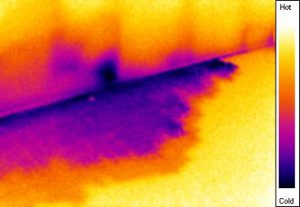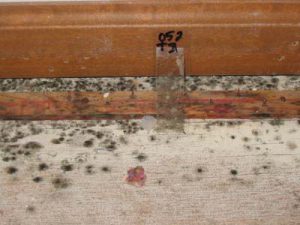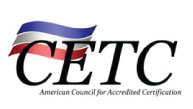Mold and Water Damage
Clean Air Sciences, Inc. offers the following mold services to assist you with the mold issues you may currently have in your home, business, or industrial facility:
- Visual and sampling investigations to determine the presence and extent of mold, bacteria, or other contaminants.
- Infrared thermography (IR) and moisture surveys to identify wet materials and water intrusion points.
- Written and photo documentation of water-damaged or mold-contaminated areas.
- Generation of a detailed report which explains laboratory results from sampling and how it affects you and your home or business.
- Report recommendations that guide mold remediation contractors with procedural specifications to achieve full remediation.
- Generation of a remediation scope of work that details the areas and materials that need to be remediated by mold contractors.
- Management of remediation projects or consultation during the project as needed.
- Post-remediation assessment and re-occupancy study to ensure remediation was complete and areas are ready for re-construction
- Mold remediation contractor contact information of companies Clean Air Sciences, Inc. has worked with and performed clearance evaluations of their work.
- Litigation and expert witness services and law firm contacts.
- Assistance with insurance claims for water damage/mold loss recovery.
- Investigations are tailored to meet your needs and financial constraints.
- Samples are shipped for next-day delivery for analysis by a laboratory that is accredited by the U.S. Environmental Protection Agency (EPA) and the American Industrial Hygiene Association (AIHA).
Sampling investigations may be performed with each sample at the discretion of the client and Clean Air Sciences, Inc. personnel will recommend sampling strategies that will provide enough investigative data to make informed decisions to solve your mold problems.
What Causes Mold Growth?
Mold growth typically occurs after some type of water intrusion, leak from appliance, roof – shingle/flashing/junction, foundation weeps or cracks, forced-building envelop penetration from severe weather, or flooding and sump-pump failure. Once an event such as these occurs mold growth will occur within 4-5 days and single-event water impact typically promotes the growth of several highly allergenic and potentially toxigenic (toxic to humans) fungi such as Aspergillus and Penicillium.
Long-term leaks over 2 weeks promote the proliferation of highly toxigenic fungi such as Chaetomium, Stachybotrys, Trichoderma, and Memnoniella all of which produce mycotoxins (toxic mold chemicals). Moldy and musty odors are from the microbial volatile organic compounds (VOCs) produced from the mold digesting what it is growing on. Mold grows very well on cellulose-based products such as drywall paper, wood, fabric, and cardboard but it may also grow on finished material if enough organic material (food) is present. Click here for a fungal glossary.
Why Mold Air and Surface Sampling is Performed
Air samples are collected to determine if occupancy issues exist from airborne mold spore levels. We dissect the data and compare results to outdoor levels and other controls as well as industry guidelines. If we think there is a health risk associated with occupying a living or workspace, we will not hesitate to recommend displacement of occupants and isolation of the area. Results are also used to determine if mold spore decontamination of living spaces and contents is necessary.
Post-remediation assessment (PRA) air sampling is performed to determine if re-occupancy of living spaces may occur and insures that mold-spore decontamination was successful or that no breach of remediation containment areas occurred. Once normal fungal levels and genera is achieved, re-construction may begin. Our guideline criteria for this assessment follow the Institute of Inspection, Cleaning and Restoration Certification (IICRC) S520 for post-remediation verification after professional mold remediation is performed.
Surface samples are collected to confirm mold growth presence since many other things may look like mold, also to determine if toxigenic or pathogenic fungi are present. Presence of growth determines whether wooden materials need to be remediated. This is also very important information for post-remediation assessment (PRA) sampling to determine if a mold remediation contractor has adequately removed the mold growth.
Mold & Water Damage Lawsuits
For legal purposes such as lawsuits and insurance claims, having laboratory data that shows mold growth or fungal structure presence is the only way to have documented proof of mold-impact.
Wall cavity bioaerosol sampling is implemented to determine if fungal amplification (growth resulting in spore production) has occurred, often from walls where water stains are present but no mold growth is apparent on finished materials such as baseboards.
Endotoxins and Mycotoxin Analysis – This is used to measure the toxins produced by mold and bacterial amplification/proliferation. The presence of these toxins is indicative of water-impacted areas.
Polymerase Chain Reaction (PCR) mold DNA analysis – DNA analysis is often used in litigation projects when the identification of genera and species of mold or bacteria is necessary to prove the presence of water impact species. Environmental Relative Moldiness Index (ERMI) is a DNA analysis of 36 fungal species that compares a panel of water-impact fungi (mold) to a panel of common mold found in homes.
Statistical analysis is performed and a number is assigned to each sample to indicate how moldy a sample area is. We have found the species data to be the most valuable aspect of the analysis for occupancy determinations and litigation evidence. Samples are collected using a dust collection apparatus in conjunction with a vacuum per the USEPA sampling method. Sample results give more of a historical rather than an airborne or real-time perspective. This is more of a CSI or forensic approach to water-impact investigations than bioaerosol or surface sampling alone.
Not all “Mold Inspectors” or Consultants are Created or Trained Equally
Things to watch out for:
- No credentials recognized by the American Council for Accredited Certification (ACAC).
- The individual had a one-day mold class and calls themselves an expert “mold inspector”.
- Consultant needs an understanding of building dynamics and physical properties of materials and the ability to think like a CSI investigator.
- Conflict of Interest: The company performs its own testing and remediation (no unbiased quality assurance to make sure they aren’t selling you unnecessary work or not doing enough). They usually offer a discount on this too.
- No applicable college degree to back up level of professionalism or relevant training in the IAQ industry.
- Investigator provides no remediation plan, no recommendations, no determination of occupancy, and no mold removal protocol or remediation scope of work.
Call an Indoor Air Quality Expert Now at 847-344-0607

Stachybotrys
Basement wall wet for prolonged time resulted in toxigenic mold Stachybotrys growth.

IR of wall leak
Foundation leak into wet carpet was not visible without IR thermal imaging.

Basement Flood
Heavy mold growth in vacant house.

Attic mold growth
Roof white mold growth from poor ventilation was toxigenic, pathogenic, and opportunistic mold Aspergillus.

Wine cellar
Mold growth from condensation in high humidity room.

Suited for safety
Mold growth up walls required a suit and mask for safety.

Air Sampling
Highrise condo air sampling for mold and bacteria.

Mold Surface Sample
Confirms mold presence and identified toxic mold.



